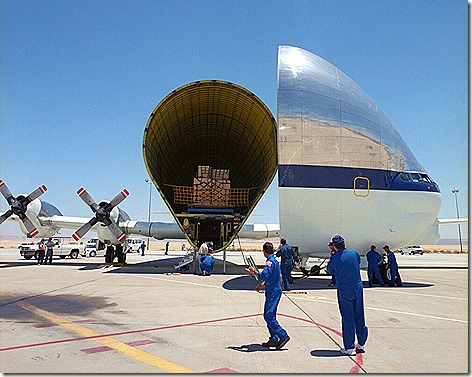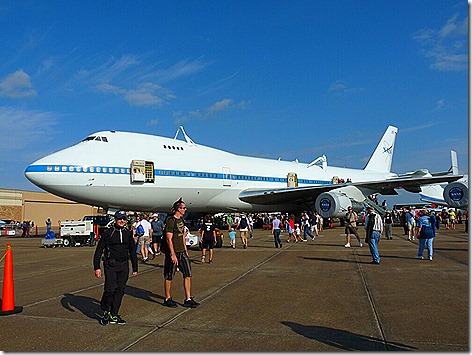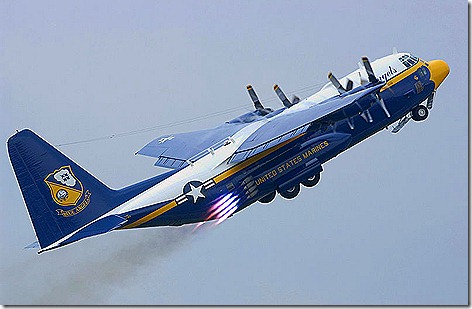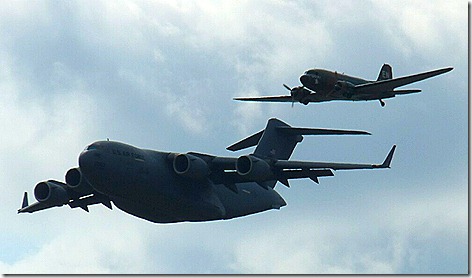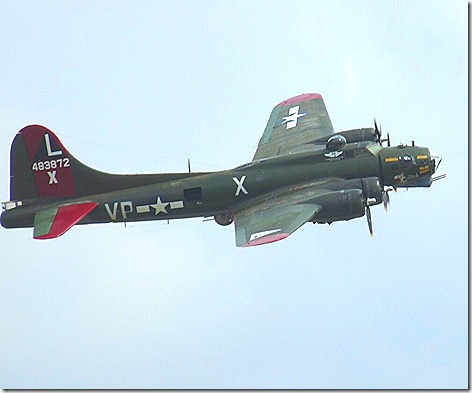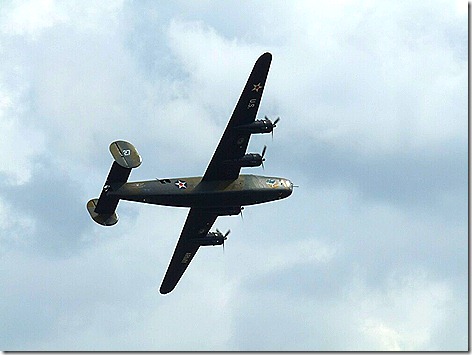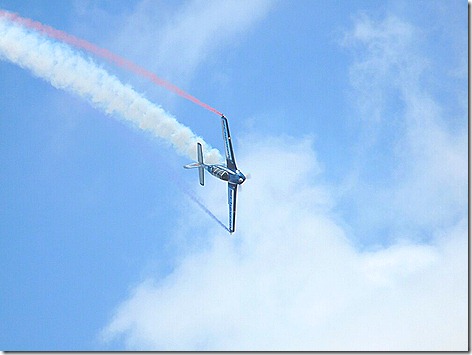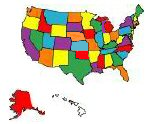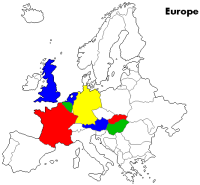Happy Birthday and Wings Over Houston . . . part 1
First off, I want to wish my wonderful Sweetie a Happy Birthday today. It’s today, the 25th, even though this is posted late on the 24th. I couldn’t have made it without you.
Yesterday we spent the day at the Wings Over Houston Airshow. We used to go just about every year when we lived here full-time, but the last time we did the show, it was 2007, right before we hit the road full-time. The problem was that the show is always the end of October, and we don’t normally get back to the Houston area until right before Thanksgiving.
But thanks to the arrival of Master Landon, we’re back early this year, so we couldn’t pass up a chance to go again.
Luckily, my Sweetie is an Air Force brat and likes air shows as much as I do. The last show we actually attended was at Eielson AFB, Alaska in June of 2008. We saw the AF Thunderbirds then, too, just like we saw yesterday.
The first thing we saw walking thru the gate was NASA’s Super Guppy. This is the last one of four that is still flying. We saw one one of the others this past February at the Pima Air & Space Museum in Tucson, AZ. The later ones were kind of Frankenstein’s monsters, patched together from several different aircraft types, including C-97J’s, Boeing 707’s, and others.
NASA used these to transport large rocket, Shuttle, and Space Station parts around the country.
The next thing we came across was NASA’s 747 Shuttle Transporter. I guess this will end up a museum pretty soon.
Right next door was one of NASA’s T-38’s. The astronauts use these to keep their flying hours current and to fly back and forth to the Cape. I spent some time working on these back in the 80’s. They were also used by NASA to fly along side during the Shuttle’s approach and televise the landings right down to the runway, and the NASA contractor I worked for maintained the cameras.
The show started out with the landing of the Flag by the REMAX Jump Team.
Here is a C-17 backing out to the flight line. It’s neat to see these newer jets backing up on their own, without a tug to push them out.
An AH-64 Apache attack helicopter
A P-40 Warhawk. This was the plane used by the AVG (American Volunteer Group) Flying Tigers flying in China against the Japanese before America entered the war. Later, after America entered the war, this group, known as the ‘Black Sheep” Squadron, of Baa Baa Black Sheep fame, was absorbed in the US Marines.
A Grumman F8F Bearcat. One of my favorite WWII planes, the Bearcat was designed to out-fly any German or Japanese plane in the war. Unfortunately, it did not enter active service until right after the war ended. It was the last new prop plane ordered by the military. Flown by the Blue Angels from 1946 to 1950, in 1946 it set a world time to climb record of 94 seconds to 10,000 feet. This record was not broken until well up into the century series of jets.
An AD-1 Skyraider. Another plane delivered too late for WWII, the Skyraider, (nicknamed the ‘SPAD’), was used as a ground attack plane as late as the Vietnam War.
One of several B-17’s at the show.
Close-up of the engine on another B-17.
A C-130 landing. Up until a few years ago, one of the demo flights here at the airshow was a JATO short field takeoff which was very impressive. JATO stands for “Jet Assisted Take Off”, but they’re really RATO “Rocket Assisted Take Off”, units, and are used to basically just ‘jump’ the plane into the air with little or no take-off roll.
Here’s a shot of the Blue Angels C-130 transport doing a RATO take-off at another airshow. Supposedly they don’t do the demos anymore because they don’t make the RATO bottles anymore and the supply is starting to run low.
Bummer! Watching a big C-130 just leap into the air and start flying is really something.
A B-25 Mitchell bomber, like the ones used in Jimmy Doolittle’s famous Raid on Tokyo in April 1942, the first US raid to strike the Japanese homeland.
An F4U Corsair. Called “The Whistling Death” by Japanese pilots due to the sound it made in a steep dive, the Corsair more than out-matched the Zero in all regimes except slow speed. And being very well armored, it was also hard to shoot down. “Pappy” Boyinton, leader of the Black Sheep Squadron, is credited with 22 kills in one.
An SB2C Helldiver. This is the last one still flying in the world.
As usual, the crowd was very large. especially since the weather was so good.
A C-17 C-47 Heritage Flight, showing 70 years of cargo plane history.
Tora, Tora, Tora. Every airshow they do an Attack on Pearl Harbor reenactment with a lot of planes in the air,
and a lot of big explosions on the ground, along with very large balls of fire coming up. They also do reenactments of the Battle of Midway, and a Vietnam War firefight.
And, up until a few years ago, they always finished up with the A-Bomb drop on Hiroshima, but, apparently that was deemed offensive by some, and it was discontinued.
So it seems OK to show the Japanese attacking us, but it’s not politically correct to show us attacking the Japanese. Who knew?
This AT-6, SNJ, Harvard, Zero Heritage Flight shows the various models of the venerable AT-6 advanced trainer, including the one in front made up as a Zero for the movie “Tora, Tora, Tora”.
A P-51C painted in the colors of the famed “Red Tail” Squadron flown by the Tuskegee Airmen.
A couple of shots of two of the B-17 Flying Fortresses at the show.
A B-24 Liberator. The B-24 holds the record as the most produced American military aircraft, at over 18,000 units. At its peak, Ford’s Willow Run plant was building one an hour.
As compared with the more famous B-17, the B-24 was faster, had better range, and carried a larger bomb. But it was harder to fly, and due to its design, more prone to battle damage. Also, it’s high wing design was much less safe during a ocean ditching, or a crash landing.
B-52
This A-10 Warthog was the jet-age replacement for the AD-1 Skyraider, and excels as a ground attack and tank killer.
The UH-1 Iroquois as known as a ‘Huey’. The Huey got its nickname from the fact that the original designation for the helo was the HU-1, and although it was changed to UH-1 in 1962, the name Huey stuck.
This one is still flying, so it’s obvious that Nick Russell hasn’t been around.
One of several aerobatic displays, this one flown in a T-34 Mentor trainer is amazing due to the fact that the T-34 is not really considered a aerobatic plane. The pilot, a retired airline captain named Deborah Rihn-Harvey with over 30,000 hours with Southwest Airlines, does some outstanding maneuvers with the T-34 since its oil and fuel systems are not certified for inverted flight.
I’ll finished up the rest of the show tomorrow since this has been a long post.
More then…
Thought for the Day:
"You can get much farther with a kind word and a gun than you can with a kind word alone." –Al Capone
adf




